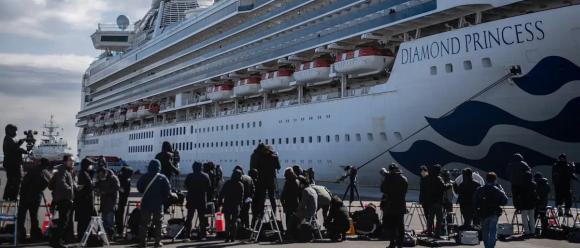 While there is an understandable concern for the passengers on cruise ships struck by the coronavirus, the crews are often overlooked. What challenges do they face and what happens to them when the last passengers leave the ships?
While there is an understandable concern for the passengers on cruise ships struck by the coronavirus, the crews are often overlooked. What challenges do they face and what happens to them when the last passengers leave the ships?
Nowhere to Hide
When the cruise ship Diamond Princess was quarantined in Japan with over 3,500 passengers and crew aboard, videos began appearing on social media of passengers in their staterooms, often with balconies, providing commentary on their rather comfortable confinement. Occasionally a crew member would appear at a stateroom door to deliver meals and refreshments.
While the passengers posted to Youtube, the hard-working crew had no place to hide from the virus. Roughly half of the 1,000 crew aboard the ship shared staterooms with at least one other crew member. They worked and ate together. They served the needs of both healthy and sick passengers. When one got sick there was limited space to quarantine the infected worker. Of the 700 infected aboard the Diamond Princess, at least 85 crew members tested positive for the virus. Aboard the Grand Princess, only 45 aboard were tested for the virus. Of the 21 found to be infected, 19 were crew and only 2 were passengers.
Worse Than The Virus, Losing Their Jobs
The coronavirus has impacted far more ship’s crews than those who are infected. The North American cruise ship market, which represents roughly half the world’s cruise ship capacity, is currently shut down for at least a month. Many ships serving the European and Asia markets have also ceased operations. What has happened to the crews of these ships?
Most cruise ship employees are contract workers hired by manning agencies on behalf of the cruise lines. They sign aboard for fixed contracts, but if there is no work they are sent home.
The Washington Post reports: “With what happened to Diamond Princess in Japan and Grand Princess in Oakland, all cruise vessels will be affected,” said Nelson Ramirez, president of United Filipino Seafarers. “They won’t leave because there aren’t any passengers. There will likely be only a skeleton crew just to maintain the ship [while anchored] — so many Filipino seafarers will be laid off on those cruise ships.”
Filipinos make up about a quarter of the world’s maritime workers, a large fraction of which are on cruise ships, according to United Filipino Seafarers. The union estimated more than 325,000 Filipinos worked aboard a ship in 2018.
Ramirez said workers aboard ships whose contracts end early should receive some amount of paid leave. But those who are ashore will not.
“If you are not on board, there’s no salary. But those who are there whose contracts are cut short, they have to be paid,” he said. “Every seafarer is a contract worker. After our contract — six months, eight months, or one year — after that, we wait until we’re hired again. If cruise ships are anchored, they won’t get work.”
“It will really have a big impact. So many will suffer,” Ramirez said. “If this continues, I’d guess 70 percent of [Filipino workers] will be out of a job. Just on the Diamond Princess, there were 500 Filipino crew members. If you had 10 ships, that’s already 5,000 people.”
There are now well over 100 cruise ships out of service due to the repercussions of the coronavirus.

Yet the hiatus is only temporary. Once everyone contracts it, it will be business as usual.
No Willy its not that simple.
Rick thank you for this Post, from the beginning I have been very concerned for the crews. For 50 years of which about 30 was in passenger ships these ladies and gentlemen have been my shipmates. One met persons from dozens and dozens of countries, and if one paid attention it was a university education of the nations of the World language and culture.
Looking out from the now closed City of Miami Beach beaches there are several cruise ships at anchor and it is sad to think of their crews trapped on board.
Good Watch
Thanks for this post but I still have questions maybe someone can answer.
Are the workers that left ships being quarantined as a group? Are they being added to local communities where they’ve anchored and also told to shelter in place? Or are they each individually trying to head to their home countries by ship or plane?
And, before disembarking were they screened and tested?
Based on media reports and press releases, ships with cases of the virus have generally quarantined the crews either on shipboard or at shore-based facilities. Once the quarantine period was over they were flown home. In the case of the Diamond Princess, they appear to have been moved ashore in groups. The last 130 were off the ship by the beginning of March. Princess Cruises hired Australia-based company Aspen Medical to provide care to crew members quarantined in Japan.
In the case of the Grand Princess, the crew appears to have been kept aboard the ship for the quarantine period. All the crew were screened but not tested before being disembarked to fly home. (The passengers on the Grand Princess were also screened but not tested before being sent to quarantine.)
Ships taken out of service without any cases of the coronavirus aboard had their crews sent home usually on chartered flights. Skeleton crews remain aboard to look after the ships.